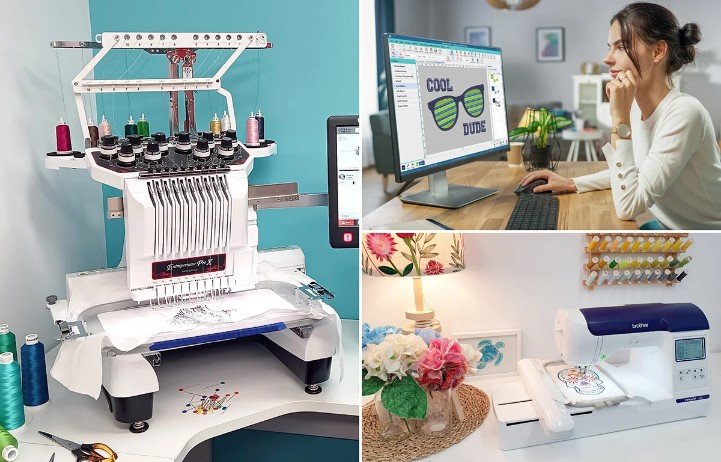Introduction: The Allure of Instant Gratification
You discover the perfect design online at 10 PM. Your embroidery machine sits ready, and you envision finishing your project before bedtime. An instant online converter promises to transform your image into an embroidery file with a single click. It’s tempting, fast, and incredibly convenient. But does this convenience come at the cost of quality? The world of digitizing embroidery has seen significant technological advances, with artificial intelligence and machine learning promising to automate what was once a skilled craft. As these instant services become more sophisticated, many embroiderers wonder if they’ve finally reached the point where they can trust automated conversion for their projects. The answer isn’t a simple yes or no—it depends on your standards, your project requirements, and your tolerance for troubleshooting.
How Instant Converters Actually Work
Understanding what happens behind the “convert now” button helps explain why results vary so dramatically. Instant online converters typically use algorithmic processing rather than human decision-making.
These systems generally follow this process:
-
Image Analysis: The software scans your uploaded image for color changes and edges
-
Automated Tracing: Algorithms identify shapes and boundaries within your design
-
Stitch Assignment: The system applies predetermined rules for assigning stitch types
-
Path Generation: Software creates a stitching sequence based on general principles
-
File Output: The system exports your design in the requested format
The entire process typically takes seconds, compared to the 30 minutes to several hours a professional might spend on the same design. This speed comes from using standardized approaches rather than customized solutions for each design.
The Reality Check: Where Instant Converters Shine
For certain applications, instant converters can deliver acceptable results that might meet your needs.
Simple Designs with Clear Contrast
Converters handle basic shapes and high-contrast designs reasonably well. Think solid silhouettes, bold lettering, or simple geometric patterns where colors are distinct and edges are clear.
Personal Projects and Experimentation
When you’re making something for personal use or testing a concept, the lower quality might be acceptable. If a design doesn’t work perfectly, you haven’t lost significant money or compromised a client’s project.
Extremely Tight Budgets
For those with literally no budget for professional services, free converters provide access to basic digitizing embroidery capabilities that wouldn’t otherwise be available.
Learning and Understanding
Using instant converters can help beginners understand basic concepts of how designs translate from image to stitches, providing a starting point for learning more advanced techniques.
The Compromise: Where Automated Conversion Falls Short
The limitations of instant converters become apparent when you move beyond the simplest projects or have quality expectations.
The Underlay Issue
Most instant converters completely ignore or poorly execute underlay stitching—the foundation layer that prevents puckering and stabilizes fabric. This single omission often leads to the puckered, distorted results that frustrate many users.
Complex Design Challenges
Converters struggle with:
-
Small Text: Letters often become blurred or unreadable
-
Fine Details: Intricate elements turn into thread clumps
-
Color Gradients: Subtle shading becomes blocky color sections
-
Overlapping Elements: Layers may stitch in illogical sequences
One-Size-Fits-All Approach
Automated systems can’t account for:
-
Different fabric types and their unique characteristics
-
Specific garment applications (caps versus flat fabrics)
-
Special effects like 3D puff or specific texture requests
-
Design size variations and their impact on detail preservation
The Hidden Costs of “Free” Conversion
While instant converters advertise low or no costs, the true price often reveals itself in other ways.
Material Waste
A poorly converted file can ruin expensive materials. That “free” conversion might cost you a $25 garment, specialty thread, and stabilizer when the design stitches out poorly.
Time Investment
What you save in money, you often pay in time through:
-
Multiple conversion attempts with different settings
-
Testing and troubleshooting problematic files
-
Manual editing in other software programs
-
Communication with disappointed clients or recipients
Opportunity Cost
Time spent fixing automated conversions is time you could have spent creating, marketing, or growing your embroidery business.
When to Consider Instant Conversion
Despite their limitations, instant converters have their place in a modern embroiderer’s toolkit.
Rough Drafts and Concept Testing
Use converters to quickly visualize how a design might look before investing in professional digitizing. The results can help you decide if a concept is worth pursuing.
Non-Critical Personal Projects
For items where perfection isn’t necessary—think quick gifts, personal items, or experimental pieces—instant conversion might be perfectly adequate.
Educational Purposes
If you’re learning about digitizing embroidery, using instant converters can help you understand basic principles before advancing to more sophisticated software.
Extremely Simple Designs
For basic shapes, single-color designs, or projects where the “handmade imperfect” look is acceptable, converters can sometimes deliver workable results.
The Professional Alternative: When Human Expertise Matters
Understanding when to choose professional digitizing embroidery services helps you make informed decisions about your projects.
Branding and Business Applications
Whenever your embroidery represents your business or brand, professional digitizing ensures quality that reflects your standards. This includes:
-
Company logos and uniforms
-
Products for sale
-
Client projects
-
Promotional items
Complex or Detailed Designs
Professionals excel at:
-
Maintaining intricate details
-
Preserving small text legibility
-
Creating smooth color transitions
-
Engineering efficient production files
Special Applications
Human digitizers can accommodate:
-
Specific fabric requirements
-
Unique garment types like caps or curved surfaces
-
Special effects and techniques
-
Large-scale production optimization
The Middle Ground: Semi-Automated Solutions
Some software platforms offer a middle approach that combines automation with human oversight.
Automated Base with Manual Refinement
These systems provide:
-
Initial automated conversion
-
Tools for manual adjustment and refinement
-
Control over stitch types and parameters
-
Ability to add proper underlay and adjust densities
Educational Software
Some programs are designed specifically for learning, offering:
-
Guided digitizing processes
-
Tutorials and help systems
-
Progressive skill development
-
Professional tools at accessible price points
Looking Ahead: The Future of Automated Digitizing
The technology behind instant converters continues to evolve, with several promising developments on the horizon.
AI and Machine Learning Advances
Future systems may offer:
-
Better recognition of design elements and intent
-
Learning from correction and feedback
-
Adaptation to specific fabric types
-
Improved stitch path optimization
Integration with Other Technologies
We might see:
-
Direct design-to-production workflows
-
Real-time conversion in embroidery software
-
Cloud-based processing with more powerful algorithms
-
Mobile applications for on-the-go conversion
Making an Informed Choice
When deciding between instant conversion and professional services, consider these factors:
Project Importance
Is this a critical business project or a casual personal item? The stakes should guide your choice.
Design Complexity
Simple designs have better success with automation, while complex artwork typically needs human intervention.
Time vs. Quality Balance
Are you prioritizing speed or perfection? Your timeline and quality requirements should align with your choice.
Budget Considerations
Consider both immediate costs and potential hidden expenses when making your decision.
Conclusion: The Right Tool for the Right Project
Instant online converters have certainly improved, but they haven’t yet reached the point where they can consistently replace human expertise for quality digitizing embroidery. They serve as useful tools for specific situations but fall short for projects demanding professional results.
The technology works best for simple designs, personal projects, and situations where perfection isn’t required. For business applications, complex designs, or when fabric and time are valuable, professional digitizing remains the superior choice.
As the technology continues to evolve, we may reach a point where automated systems can handle more sophisticated projects. For now, the most successful approach involves understanding the strengths and limitations of both options and choosing the right solution for each specific project.
Your embroidery projects deserve the best possible foundation. Sometimes that means embracing the convenience of instant conversion for appropriate projects, and other times it means investing in professional expertise. By making conscious choices based on your specific needs rather than defaulting to the easiest option, you’ll achieve better results and fewer disappointments. The perfect stitch requires the right approach from the very beginning.




Leave a Reply